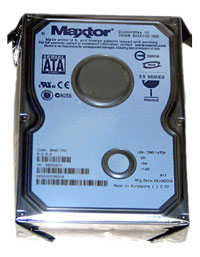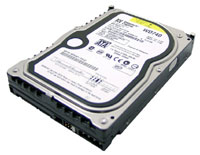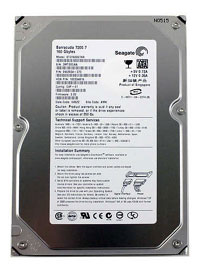Buyer's Guide - Mid-Range, January 2005
by Jarred Walton on January 21, 2005 11:09 AM EST- Posted in
- Guides
Hard Drive Recommendations
We have already said a lot on the topic of hard drives in our past Guides, and there really isn't a whole lot to add at this point in time. Higher capacity models are on the way in the not too distant future, but they will carry with them higher price tags. We recommend SATA drives for most people these days; vendors price them similarly to IDE and it is easier to route the cables. If you're into extreme overclocking, however, IDE may be worth considering. Performance isn't all that different - barring the lack of certain high-end options - and many systems have difficulty reaching top overclocked speeds with SATA drives. For nForce3 250 chipsets, we have found that SATA ports 1 and 2 are more likely to have problems than ports 3 and 4. So, unless you want more than two SATA hard drives, you should be fine.
Hard Drive Recommendation
Seagate 160GB SATA with NCQPrice: $105 Shipped
The best value in terms of price per GB of storage currently goes to the 250 GB Hitachi drive [RTPE: HDS722525VLAT80], at just under 55 cents per GB. 250 GB is a lot of storage, however - probably more than most people really need. With the added benefit of Native Command Queuing (NCQ), the Seagate drives continue to impress. The Seagate 160 GB SATA [RTPE: ST3160023AS] offers the best value of the bunch, at roughly 70 cents per GB, but you also get a longer 5 year warranty. Samsung is a slightly better bargain, so if you don't think NCQ is worth paying extra, you can pick up the 160 GB Samsung for $15 less. We give the recommendation to the Seagate drives, although all of the others that we listed are reasonable alternatives.
 |
 |
| Click images to enlarge. | |
Hard Drive Alternatives
Maxtor 300GB SATA with NCQ and 16MB cachePrice: $194 Shipped
Western Digital Raptor 74GB SATA with TCQ and 10,000 RPM
Price: $177 Shipped
On the other hand, if improved performance is what you're after, the best two choices are either one of the 16MB cache Maxtor drives or the 74GB Western Digital Raptor [RTPE: WD740GD] with its 10,000 RPM design - the Maxtor also offers NCQ while Raptors "only" offer TCQ, in case you were wondering. For storage space as well as performance, we would go with a Maxtor drive, as they are available in 250 and 300 GB models. If you're going to get a drive that large, we would go with the 300 GB model [RTPE: 6B300S0] for the small price increase - 65 cents per MB is pretty good, especially considering the larger cache. If raw speed is your primary concern, the faster rotational speed of the Raptor still wins out, but it is one of the few non-SCSI drives to actually cost more than $1 per GB. Again, we recommend the larger version for its improved performance and features over the original Raptor, but at $177, it costs $2.40 per GB. These drives are great choices, and only you can decide whether raw speed or increased storage is more important, so we recommend them both.
You could even go with a RAID 0 configuration for a possibly small increase in performance, or if you're concerned about data loss, there's the possibility of RAID 1. For a truly high-end setup, you might even think about getting three or more drives and a separate SATA controller with hardware support for RAID 5. That combines the best of both worlds, but it's more than what anyone actually needs. If you're looking into RAID 5 options, make sure that you pick up a controller card with a hardware XOR engine to calculate the parity checks, or else performance will be greatly reduced. RAID of any form is generally a high-end option, however.











46 Comments
View All Comments
JarredWalton - Sunday, January 23, 2005 - link
35 - Damn. Foiled. :) I forget these things over time. Wasn't the original Raptor TCQ and the newer version has something like "TCQ-II" which was supposed to improve on standard TCQ somehow? Anyway, our NCQ article didn't really show a major benefit for desktop use, but I've fixed the error now. Thanks!REMF - Saturday, January 22, 2005 - link
"On the other hand, if improved performance is what you're after, the best two choices are either one of the 16MB cache Maxtor drives or the 74GB Western Digital Raptor [RTPE: WD740GD] with its 10,000 RPM design - both of these also offer NCQ, in case you were wondering."the Raptor offers Tagged Command Queuing, not Native Command Queuing.
JarredWalton - Saturday, January 22, 2005 - link
Regarding post #30 and the NEC 3520A, a reader sent me an email informing me that the 3520A uses a new chipset and thus the 3500A is *not* upgradeable to the 3520A via a BIOS flash. Barring any contradicting views, I'll stick with that.JarredWalton - Saturday, January 22, 2005 - link
31 - our RTPE doesn't currently differentiate between the ST3160023AS and the ST3160827AS, unfortunately. For example, the Newegg listing currently priced at $111.50 + $4.69 shipping is the appropriate NCQ model. In reality, the NCQ doesn't seem to be a big deal for non-server systems (just like RAID), but if it's only a few dollars more why not get it? That was my feeling. There are even a couple listings in the RTPE for the ST3160021AS. Basically, the RTPE bots match items according to size and features, but NCQ doesn't seem to be something they're aware of yet.kamaboko - Saturday, January 22, 2005 - link
you know the saying, "can't please all of the people all of the time". i think that applies here. in any case, i found this guide useful since i'm looking at a near total ground up rebuild--minus dvd burner, audigy 2zs, and monitor.beakerman - Saturday, January 22, 2005 - link
"With the added benefit of Native Command Queuing (NCQ), the Seagate drives continue to impress. The Seagate 160 GB SATA [RTPE: ST3160023AS]"According to Seagate, the ST3160023AS does not feature NCQ. I believe the drive you want is the ST3160827AS, which is actually a few $$ cheaper. Both drives are 160 GB SATA.
JarredWalton - Saturday, January 22, 2005 - link
26 - Sorry, I got the wrong "updated burn speeds" in there. The 3500A is indeed capable of 16X DVD+/-R recording. The difference is that the 3520A can do DVD+RW at 8X and DVD-RW at 6X, while the 3500A is stuck at 4X for both. There's a reasonable chance, of course, that a BIOS flash of the 3500A can turn it into the 3520A. I updated the text with this information.28 - The "alternative" was meant as a closer to high-end option. 50% more for the CPU for 10% more performance is a rather expensive upgrade. The jump to the 3800+ is even worse, coming in at 100% more than the 3500+ for a 9% performance increase. I've updated the text slightly to make this more clear. For overclockers, I definitely wouldn't bother with the added cost of the 3500+.
27 - I did mention the home theater aspect for the speakers (last part of the 5300e paragraph), but we're certainly not going to spec out an entire home audio setup, so there's not much to do other than mention it. Your comment ties into the next point:
29 - 2.1 speakers aren't much cheaper than the 5.1s, and you can always just leave the rear speakers disconnected. Still, you have a point that some people really don't want more speakers. In that case, I'm not sure why they would bother with anything more than 2.0 speakers, though. There *are* great 2.0 and 2.1 speakers out there, but then you're almost better off looking at the home audio equipment instead of PC speakers. I dunno... I suppose the Swans are always an option. Anywat, I modified the text to include 2.0/2.1 speakers and headphones as something to consider, along with home theater audio. I moved this into a separate paragraph to draw more attention to it.
Dranzerk - Saturday, January 22, 2005 - link
One suggestion for next buyers guide, I think all kinds system setups like 2.1 speaker systems, you should offer a 5.1 and 2.1 for each type instead of just 5.1.I know some personally don't like 5.1 sounding speakers, and prefer 2.1 speakers.
The logitech Z3 2.1 fit that bill perfectly, you can find them for under $50 also, and they get great reviews.
Pjotr - Saturday, January 22, 2005 - link
I think you are fooling buyers into a wrongful purchase when it comes to performance. In the AMD "Upgraded" PCIe Athlon 64 System you have gone from 3200+ for $215 to 3500+ for $334. The performance increase from 2.0 to 2.2 GHz is smaller than 10 %, in many applications like games it might even be close to 0.Instead of adding $119 for this 0-10 % performance gain, I think sticking with the 3200+ CPU and changing the graphics card from 6600GT to 6800GT (Leadtek A400) is a MUCH better choise, It will cost you £377 minus $190 = $187. If you want to come down close to the $119 difference don't get an SLI motherboard.
This graphics upgrade will make wonders in anything graphics related compared to a 10 % CPU clock speed upgrade that is seldom noticed in anything.
Caligynemania - Saturday, January 22, 2005 - link
Great article, just one comment. With your reccomendation of speakers and sound card as alternatives, you really should mention that a receiver/speaker combination would probably be most people's best bets. A good receiver will run slightly more than the sound cards you mentioned, but the selection for real speakers is infinitely better than computer speakers.